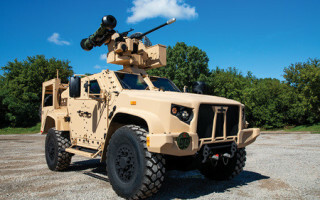Each issue, the editorial staff of Military Embedded Systems will highlight a different organization that benefits the military, veterans, and their families. We are honored to cover the technology that protects those who protect us every day.
Military Embedded Systems
Op-Eds
GUEST BLOG: From Evangelism to Mandate: The Rise of MOSA - Blog
July 26, 2023For many COTS vendors and VITA members, the Tri-Services Memo issued in January 2019 by the secretaries of the Army, Navy and Air Force was the highest validation of several decades of their combined efforts. The memorandum clearly stated that, going forward, modular open systems approach (MOSA) supporting standards “should be included in all requirements, programming and development activities for future weapon system modifications and new start development programs to the maximum extent possible.” Examples of MOSA standards include the Sensor Open Systems Architecture (SOSA) and CMOSS, both of which rely on OpenVPX hardware as their foundation.
GUEST BLOG: GaAs and GaN MMICs: Key component of defense RF electronic systems - Blog
July 21, 2023Monolithic microwave integrated circuits (MMICs) fabricated using compound semiconductors are a critical component of a multitude of RF [radio-frequency] systems. For commercial wireless applications, gallium arsenide (GaAs)-based power amplifiers are ubiquitous in the smartphone market, while gallium nitride (GaN) products service wireless base stations, SATCOM terminals, and are a core enabler of 5G systems.
The worldwide market for military ground combat vehicles and tanks - Blog
June 29, 2023WARFARE EVOLUTION BLOG. In our last adventure, we explored the worldwide military markets using three recent reports, and integrated those into the TAM-SAM-SOM model (total addressable market, serviceable addressable market, and serviceable obtainable market). That expedition gave us a macro-view of things. Now, it’s time to put on our rubber gloves, get out the sharp knives, and carve the military market into edible segments. The most objective way to dismember this massive creature is to cut it up by platform, so we’ll start with the largest volume segment: ground combat vehicles (GCV) and tanks.
GIVING BACK: Combined Arms - Blog
June 09, 2023Each issue, the editorial staff of Military Embedded Systems will highlight a different charitable organization that benefits the military, veterans, and their families. We are honored to cover the technology that protects those who protect us every day.
GIVING BACK: Disabled American Veterans - Blog
May 15, 2023Each issue, the editorial staff of Military Embedded Systems will highlight a different charitable organization that benefits the military, veterans, and their families. We are honored to cover the technology that protects those who protect us every day.
The $600 billion market for military weapons, sensor systems, and platforms - Blog
April 27, 2023WARFARE EVOLUTION BLOG. As previously promised, we are fearlessly embarking upon a challenging project here, to integrate the demand-side and supply-side data about the world military markets. The best method to attack this problem is from the top-down. Going from the bottom-up would create debilitating confusion, misconceptions, and illusions.
GIVING BACK: Dare To Dream Ranch - Blog
March 20, 2023Each issue, the editorial staff of Military Embedded Systems will highlight a different charitable organization that benefits the military, veterans, and their families. We are honored to cover the technology that protects those who protect us every day.
MOSA savings metrics needed - Blog
March 15, 2023While most leaders in the U. S. Department of Defense (DoD) understand the basic value of open architectures, they need to see metrics on already-realized cost and scheduled savings, said David Tremper, Director, Acquisition Integration and Interoperability, Office of the Undersecretary of Defense in his keynote address at the MOSA [Modular Open Systems Approach] Virtual Summit held February 22 and hosted by myself and Military Embedded Systems.
GUEST BLOG: Defense industry embraces the benefits of standardized power supplies - Blog
March 15, 2023As 2023 marches on, we are seeing a growing trend within the aerospace and defense electronics industry toward technology standardization, in particular regarding power-delivery networks. The U.S. Department of Defense (DoD) and prime defense contractors are incentivized to push standardized, modular power systems thanks to their inherent reusability, ability to scale across multiple platforms, and the clear benefits of shorter development time and faster time to revenue.
Army Project Convergence 2023 exercises canceled, and UFOs take a high-speed turn - Blog
March 14, 2023WARFARE EVOLUTION BLOG. As I was putting together my notes about all the Army’s Project Convergence Exercises, I got a notice that the planned PC-23 exercises had been cancelled and rescheduled for 2024. That’s a great disappointment, so let's drown our sorrows in a vintage bottle of data from the three previous exercises: PC-20, PC-21, and PC-22.
GUEST BLOG: As wiper threats rise, governments need better coordination, planning, and data sharing - Blog
March 14, 2023While many other types of threats still exist in the wild, the rise of wiperware – a class of malware that maliciously erases data on the infected device – has sparked special concern among security teams in the public and private sectors.
GUEST BLOG: Why Ukraine needs battle tanks: The technologies behind the multinational pledges to bolster Ukraine’s front lines - Blog
March 13, 2023A year ago, sending NATO battle tanks to a non-NATO nation fighting a war against Russia would've been unthinkable. Kyiv’s long campaign for support from western nations seemed to fall on deaf ears, even though many experts agreed that the need was there. Now, however, Germany, Denmark, and other European nations are sending Leopard 1 A5 and Leopard 2 A6 tanks to Ukraine; Britain has sent a squadron of Challenger 2s; and the U.S. is sending a battalion of 31 M1A2 Abrams tanks.
GIVING BACK: Operation Hat Trick - Blog
February 16, 2023Each issue, the editorial staff of Military Embedded Systems will highlight a different charitable organization that benefits the military, veterans, and their families. We are honored to cover the technology that protects those who protect us every day.
GUEST BLOG: How the military can speed data mobility for smart decisions on the move - Blog
February 03, 2023The military is producing ever-larger amounts of valuable data from embedded systems at the edge. Now it needs more effective ways to share, understand, and act on that data – at or near the user and as close as possible to real time. By leveraging available technologies like containerization and tools to manage them, warfighters have the opportunity to make faster, smarter decisions where and when they’re needed to help achieve battlespace dominance.
-
Training and simulation systems to support Saab GlobalEye under new CAE agreement
November 21, 2025
-
Next-gen pilot training system to be developed by Saab, Boeing, and BAE Systems
November 19, 2025
-
KC-390 refueling capability validated with Gripen E in Brazilian test campaign
November 17, 2025
-
F-35 air combat training subsystems to be delivered by Cubic
November 13, 2025
-
Terma acquires OSL Technology to boost counter-UAS, infrastructure protection offerings
November 27, 2025
-
EDA project to reduce noise from autonomous underwater vehicles
November 25, 2025
-
Littelfuse Expands X4-Class Portfolio with 200 V, 480 A Ultra-Junction MOSFET in SMPD-X Package
November 25, 2025
-
Uncrewed systems pact for Baltics signed between Quantum Systems and ADV Defense
November 25, 2025
-
AI wargaming platform to be advanced for U.S. Air Force by AMESA
December 03, 2025
-
Image generator for military training using Unreal Engine introduced by Lockheed Martin, Blackshark.ai
December 03, 2025
-
AI-enabled counter-UAS system wins Army competition
November 24, 2025
-
Command-and-control task order to advance multi-domain capabilities under new COBRA award
November 21, 2025
-
Beyond GPS: HORDE PNT for contested environments
December 04, 2025
-
Beyond GNSS/GPS: magnetic navigation and multisensor resilience in contested skies
December 04, 2025
-
Power under pressure: Meeting the military’s surging energy demands
December 04, 2025
-
Shield AI, Sedaro partner to build software to support on-orbit operations
December 04, 2025



















